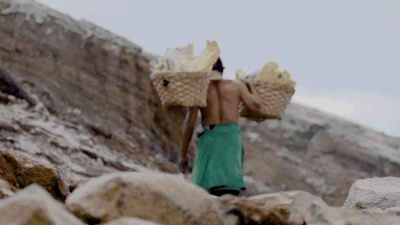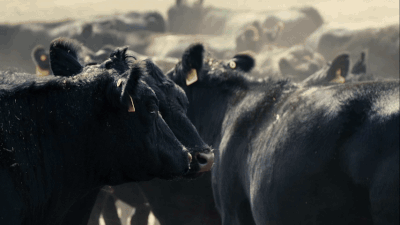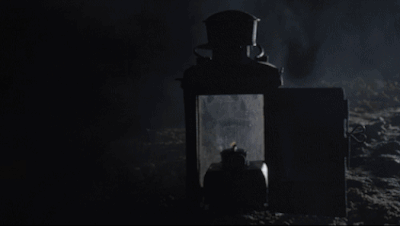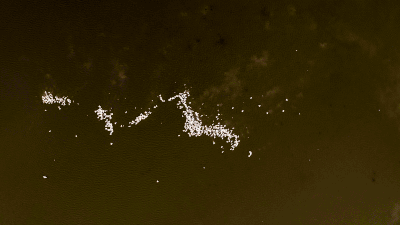Productions
For more than 50 years, sulfur mining has shaped daily life at the Ijen volcano complex—a chain of composite volcanoes straddling the border of Banyuwangi and Bondowoso Regencies in East Java, Indonesia. This harsh, alien landscape is famed for its surreal blue fire and a highly acidic crater lake, but it's also home to one of the most grueling forms of manual labor on Earth.
Each day, around 300 miners climb over two miles up the steep slopes of Gunung Ijen. From there, they descend more than 900 yards into the toxic crater to extract chunks of bright yellow sulfur, known locally as "Devil’s Gold." The name reflects both the substance's vivid color and the danger involved in collecting it. Despite the suffocating sulfur dioxide fumes, extreme heat, and lack of protective gear, the miners carry baskets weighing up to 90 kilograms (200 pounds) back up the crater and down the mountain, making multiple trips per day.
The work is physically punishing and hazardous to health. Prolonged exposure to sulfur gas leaves many with respiratory issues, burned skin, and scarred bodies. These miners—some of whom have worked here for decades—bear the visible marks of their labor: poisoned lungs, chemical burns, and backs permanently hunched from the weight they carry. Yet for many, the income is essential in a region where alternative employment is scarce.
moreThe Cape Town Water Crisis "Day Zero"—a phrase that typically signifies the final moment in a countdown—has long belonged to the realm of science fiction, often associated with dystopian futures and apocalyptic collapse. But in early 2018, this abstract concept became an imminent reality for Cape Town, South Africa—a modern metropolis of over four million people.
For the first time in modern history, a major city faced the possibility of its municipal water supply running dry. If Day Zero arrived, taps across the city would be turned off. Residents would have to queue at designated collection points under armed guard to receive their daily water rations. Schools, hospitals, businesses—life itself—would be profoundly disrupted.
What was once unimaginable had become terrifyingly real: a city on the verge of complete water depletion. Cape Town’s Day Zero was no longer a warning of things to come. It was a moment poised to redefine how the world thinks about water, resilience, and survival in the age of climate change.
With Alan Winde Western Cape Provincial Minister of Economic Opportunities Ian Douglas Neilson Deputy Mayor of Cape Town Sheikh Abduragmaan Alexander Religious Minister at Masjidul-Quds Chantelle Albury scenario strategist and bestselling author
moreThe Belgica expedition
The Belgica expedition, led by Adrien de Gerlache, was the first to overwinter in Antarctica (1897-1899). It was a groundbreaking scientific voyage that charted new lands and oceans, while also facing extreme conditions and chal-lenges. The expedition is considered the first of the Heroic Age of Antarctic Exploration.
First wintering in Antarctica:
The Belgica became trapped in the ice of the Bellingshausen Sea from March 2, 1898, to March 14, 1899.
While described as a Belgian expedition, it included a diverse international crew, with members from Belgium, Norway, Poland, Romania, and the United States.
The expedition gathered significant scientific data, including a full year of meteorological observations, and conducted research in geology, oceanography, and biology.
The crew endured a sunless polar winter, faced the threat of scurvy and starvation, and dealt with the psychological strain of isolation.
Adrien de Gerlache led the expedition, while Roald Amundsen (later the first to reach the South Pole) and Frederick Cook (a doctor and photographer) were also part of the crew. Cook played a crucial role in maintaining morale and helping the crew survive the harsh conditions. The Belgica expedition laid the foundation for future Antarctic exploration and proved that humans could survive extended periods in the Antarctic environment.
moreJános Botond Kiss, an internationally renowned research biologist, has been living in and studying the Danube Delta for six decades. His oeuvre, books, hundreds of research papers present one of the most comprehensive collections within the body of scientific work on the Danube Delta. He has been exiled, has faced severe political discrimination. He founded the Danube Delta’s Corps of Guards and Inspectors, served as secretary of state for environmental protection; meanwhile, throughout his career, he remained a passionate natural scientist and a devoted advocate for the protection of the endangered animals, plants, natural habitats of the region.
moreHigh in the heart of the Swiss Alps, where ancient ice has carved valleys for millennia, a quiet ritual unfolds each summer. In the shadow of towering peaks, locals and scientists come together to wrap the Rhône Glacier—one of Switzerland’s most iconic ice masses—in massive white blankets.
The documentary tells the story of an extraordinary act of protection and hope. As climate change accelerates glacial melt across the globe, Switzerland has adopted a surprisingly simple yet symbolic response: covering parts of its glaciers with reflective thermal blankets to slow the loss of ice. The effort is small compared to the scale of the problem, but it speaks volumes.
Following the journey of the community members and glaciologists who trek each year to the melting edge, Switzerland Protects the Alps with a Blanket reveals a nation’s intimate connection with its disappearing glaciers. The film explores the science behind the practice, the challenges of preserving cultural and environmental heritage, and the emotional toll of watching these frozen giants retreat.
At once poetic and urgent, this is a story of human ingenuity, resilience, and the deep love of a people for their mountains.
more- Genres: Documentary
- Running time: 50 min
- Language: Romanian
- Subtitles: English
- Synopsis:
- The village of Tichilesti is in a remote area of easternmost Romania, in the in a hidden forest near the Danube Delta it is home to what is thought to be Europe's last remaining leprosy colony. The establishment has an over 100 years long history, where all the leprosy affected people from all regions of Romania and neighbouring countries had been isolated. Most inhabitants had spent their entire life in Tichilesti, hidden from the eyes of the outside world, a society that had stigmatized and marginalized them mostly because of fear. During the decades of the Ceausescu dictatorship, the colony remained a carefully guarded secret of communist Romania, a blemish of the "communist Eden".
- "The Colony" presents the life of the last residents, who were taking care of by the devoted Dr Rasvan Alexa Vasiliu, the one who opened the possibility for their social integration and rehabilitation.
- Doctor Rasvan Alexe Vasiliu has dedicated his life to caring for Hansen’s disease patients for over two and a half decades. Thanks to his devotion, today the leprosy hospital is a modern medical unit meeting European standards. Thanks to the effective treatment, at present, Tichilesti residents can move freely in the society of the healthy. Grigore "Grișa" Grigorov has also come from the Delta, from the area where the Danube flows into the sea. He trained to become a carpenter, and finished trade school while keeping the ailment already afflicting him a secret. Stela Mitulescu, Dumitru Ifemia, Vasile Olescu, Romică Nedelcu, Tutu Aurelian and "Anonymous"—they have also been living in Tichilesti most of their life. The residents of the colony used to get married, have children. It was here that Domnica Mișcov was born from infected parents. She has lived her whole life here and never wanted to leave. Shot in an observational/participative style, the documentary took over ten years to film, amassing hundreds of hours of footage, including archival footage and deep interviews with the last residents and medical staff of the colony. It follows the story of the long-term residents, their struggles to reintegrate in the outside world. Will they be able to adapt to a relative normal life and will they ever be able to successfully join the world of the "healthy"?
- "The Colony" is the only audiovisual document that preserves the history of leprosy in Romania, the memories of the last residents of Tichilesti and of those who had already left it.
- Dedicated to those suffering from leprosy.
- ▷ Watch trailer:
The Galápagos Islands, a volcanic archipelago 1,000 km off Ecuador’s coast, are famed for their unique wildlife. Many species found here exist nowhere else on Earth. Charles Darwin’s 1835 visit inspired key ideas in his theory of evolution. Today, climate change and warming waters threaten iconic species like the marine iguana, along with many others.
more


